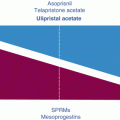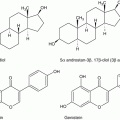© International Society of Gynecological Endocrinology 2016
Andrea R. Genazzani and Basil C. Tarlatzis (eds.)Frontiers in Gynecological EndocrinologyISGE Series10.1007/978-3-319-23865-4_2424. Body Identical Hormone Replacement: The Way Forward?
(1)
Department of West London Menopause Service, Queen Charlotte’s & Chelsea and Chelsea & Westminster Hospitals, Imperial College London, London, UK
24.1 Introduction
The adverse outcomes seen in WHI [1] were mainly due to an over-dosage of hormones in a relatively elderly population. However, fundamental differences exist between conjugated equine estrogens and 17 beta estradiol and between medroxyprogesterone acetate and natural progesterone. It is likely that these differences also contributed to the adverse outcomes in WHI, which were contrary to the cardiovascular benefits seen in previous observational trials. Recent studies of cardiovascular risk markers in younger women have been designed using predominantly estradiol and natural progesterone (transdermal and oral) as the primary interventions. This chapter reviews the effects that body identical estradiol and progesterone can have, both in the physiological environment and also when replaced as transdermal estradiol and micronized oral progesterone.
24.2 What Are Bio-identical Hormones?
“Bio-identical hormones” are precise duplicates of estradiol, estriol, estrone, progesterone, DHEA, and testosterone as synthesized by the human ovary and adrenal. However, this is a marketing term, and “bios” is a Greek term referring to “life.” A more accurate way to refer to these hormones is “body identical” [2]. This chapter will focus on the possible differential effects of transdermal estradiol and micronized progesterone. Although androgens have a vital role to play in hormone replacement, there is a general agreement that testosterone should be delivered non-orally in a physiological formulation and dosage.
24.3 Why Is There Controversy?
Compounding pharmacies market their own unregulated bio-identical products promoted in a number of countries by high-profile celebrities. Some practitioners prescribing these compounded preparations claim to be able to calculate the precise level of each deficiency from salivary hormone levels and then replace the precise amount using estrogen, progesterone and testosterone delivered by lozenges or creams. This practice is not supported by evidence for efficacy or safety. In reality, imbalances of estrogen and/or progesterone can lead to problems such as endometrial hyperplasia. It is high time the regulatory authorities took this issue seriously and introduced a statute to prevent these unregulated products from being freely sold on the open market. The US Senate has passed a bill on bio-identical hormones to bring these products under Food and Drug Administration (FDA) regulation. It will take some time before this is fully implemented. The North American Menopause Society (NAMS) is concerned about pharmacy compounders who operate as manufacturers without following Good Manufacturing Practices. NAMS has called for the manufacturers of body identical hormones to register with the FDA. Bulk chemicals should be identified and checked for quality and purity. Standard information should be provided on risks and benefits of the product. There should be appropriate investigation and reporting to the FDA of adverse events potentially related to the drug.
24.4 Are There Any Differences Between Bio-identical and Non-Bio-identical Hormones?
The most significant difference, in terms of biological effect, is with the progesterone component. The synthetic analogues of progesterone, i.e., progestins/progestogens, were developed to make the hormone available orally before the process of micronization had been developed. Unfortunately, in addition to binding to the progesterone receptor, many of these compounds also bind to the glucocorticoid, mineralocorticoid, and androgen receptors. This binding can lead to unwanted side effects such as unfavorable glucose metabolism, fluid retention, acne, and weight gain [3]. The progesterone molecule binds primarily to the progesterone receptors to produce the desired effect in the endometrium, i.e., secretory transformation. There is some weak binding to the mineralocorticoid receptor, but here, there is an antagonistic effect, which gives it mild diuretic properties. Progestogens and progesterone bind to the progesterone receptors in the central nervous system. Both can lower mood through stimulation of the neurotransmitter gamma amino butyric acid GABA; while progesterone has a mild sedative effects through its intermediate metabolites, progestogens tend to cause anxiety and irritability [4].
Synthetic forms of estradiol, e.g., valerate, are cleaved at an early stage during GI absorption leading to delivery of bio-identical estradiol. The biological effects of conjugated equine estrogens are complex and have still not been fully evaluated.
24.5 Does the Route of Administration Make a Difference?
There are some fundamental differences between oral and transdermally administered estradiol due to the avoidance of first-pass hepatic metabolism. In theory, transdermal delivery manifests in a more physiological systemic effect; factors of coagulation are not activated and neither is the renin-angiotensin-aldosterone cascade, thus minimizing the risk of venous thrombosis and hypertension [5].
24.6 Effect on the Cardiovascular System
Micronized progesterone has several properties which facilitate a neutral or positive effect on the cardiovascular system. There appears to be a neutral effect on lipid and glucose metabolism and on vascular tone. Thus, the beneficial effects of estrogen are not attenuated as they are with some synthetic progestogens such as MPA, which can blunt the increases in HDL [6]. Progesterone also has beneficial effects by preventing the growth and movement of cells involved in the formation of arteriosclerotic plaques and relaxes arterial smooth muscle via enhancement of nitric oxide from the endothelium. Conjugated equine estrogens lead to greater increases in triglycerides than 17 beta estradiol, but it is unclear how significant this is as far as cardiovascular disease risk is concerned.
New randomized trials such as KEEPS [7] and ELITE [8] have been designed to study body identical hormones in the expectation that there will be a more favorable effect on cardiovascular risk markers. In both studies, micronized progesterone has been used as progestogenic opposition. Preliminary data from KEEPS reported at the North American Menopause Society meeting in October 2012 showed a significant improvement in the quality of life with no significant effect on carotid intima media thickness, coronary calcium scores, and lipids and insulin resistance. The ELITE study showed a significant reduction in carotid intima media thickness of body identical hormone therapy versus placebo in the early post-menopausal group (p = 0.007) of women.
24.7 Effect on Venous Thromboembolic (VTE) Risk
There are differential effects of transdermal estradiol and micronized progesterone on the cardiovascular system. There is lack of a procoagulant effect of transdermal estradiol with the absence of thrombin generation and resistance to activated protein C. This may result in primary prevention benefits for myocardial infarction and diabetes, although larger studies would be desirable to confirm this. The type of progestogen seems to negate even the route of administration of estrogen. Observational data suggest that the use of progesterone-derived progestogens may modulate the increased risk conferred by oral estrogen. There was no modification of VTE risk regardless of route of estradiol administration with an odds ratio of 0.9 (CI, 0.6–1.15) in the E3N study [9] and an odds ratio of 0.7 (CI, 0.3–4.9) in the ESTHER study [10].
Stay updated, free articles. Join our Telegram channel

Full access? Get Clinical Tree





